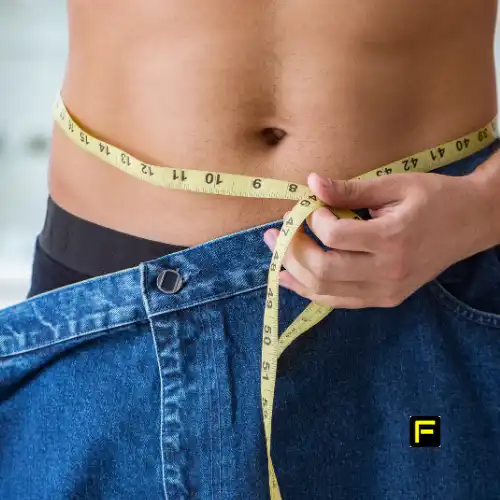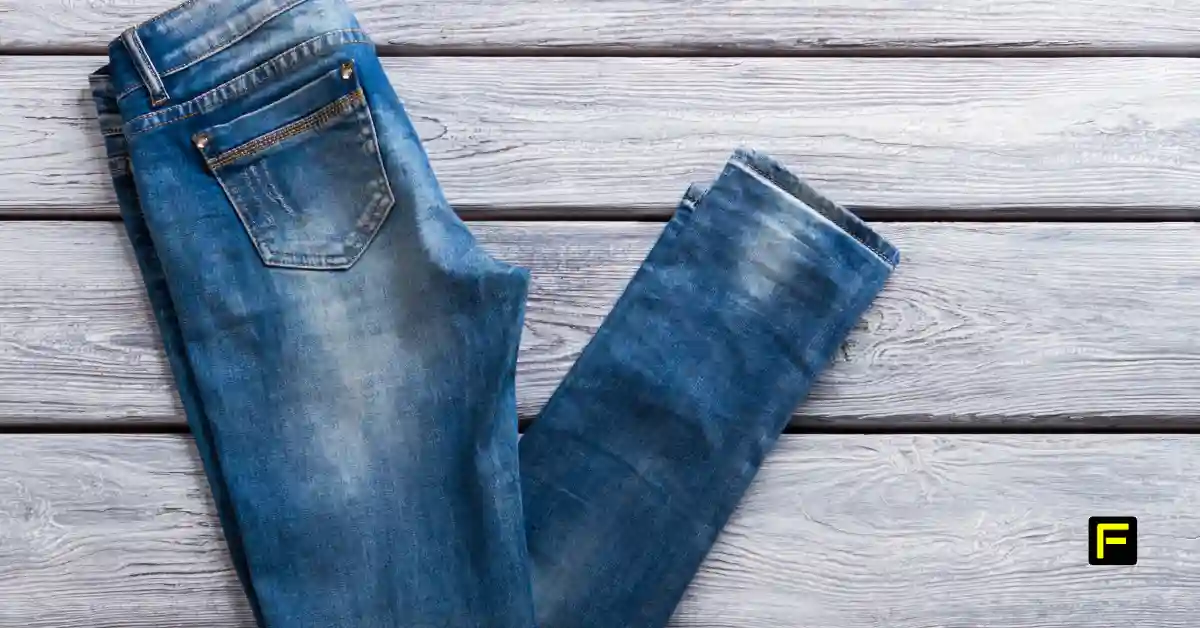The Definitive Measurement System for Men Over 50 with Flat Buttocks
Created by the team at FitFab50.com, experts in helping mature men find clothing that fits their changing bodies

Introduction
Finding jeans that fit properly when you have a flat buttocks can be frustrating, especially as our bodies change after 50. Standard measurement guides don’t address the specific challenges faced by men with flat seats. This flat seat measurement guide provides a step-by-step approach to accurately measure your unique proportions so you can find jeans that fit comfortably and flatteringly.
What You’ll Need
- Flexible measuring tape (cloth type used for sewing)
- A friend to help (for most accurate measurements)
- A mirror
- A firm chair
- This printed guide
- Pencil to record measurements
The Essential Measurements for Men with Flat Buttocks
1. True Waist Measurement
Why it matters: Many men over 50 wear jeans below their natural waistline. Knowing your true waist helps determine how much the waistband will need to curve to prevent gapping.
How to measure:
- Stand in a relaxed position
- Find your natural waistline by bending slightly to the side – the crease that forms is your natural waist
- Measure around this point, keeping the tape parallel to the floor
- Record in inches: _______ inches
2. Wearing Waist Measurement
Why it matters: This is where you actually wear your jeans, which is often lower than your true waist.
How to measure:
- Stand in a relaxed position
- Place the measuring tape where you typically wear your jeans
- Ensure the tape is snug but not tight
- Record in inches: _______ inches
3. Seat/Hip Measurement
Why it matters: The difference between your waist and seat measurements determines how much the jean needs to accommodate your shape. For men with flat buttocks, this difference is often smaller than pattern makers expect.
How to measure:
- Stand in a relaxed position
- Measure around the fullest part of your hips/seat (usually about 7-9 inches below the waist)
- Make sure the tape remains parallel to the floor
- Record in inches: _______ inches
4. Waist-to-Seat Differential
Why it matters: This calculation reveals why standard jeans gap at the back for men with flat buttocks.
How to calculate:
- Subtract your Wearing Waist measurement from your Seat measurement
- Standard jeans are designed for a 6-8 inch difference
- Men with flat buttocks typically have a 2-5 inch difference
- Your differential: _______ inches
5. Front Rise Measurement
Why it matters: Affects comfort when sitting and helps determine if the jean will provide adequate coverage.
How to measure:
- While wearing a pair of pants, measure from the center front of the waistband straight down to the crotch seam
- Record in inches: _______ inches
6. Back Rise Measurement
Why it matters: CRITICAL measurement for preventing “plumber’s crack” – most men with flat buttocks need a longer back rise than standard.
How to measure:
- While wearing a pair of pants, measure from the center back of the waistband straight down to the crotch seam
- For men over 50 with flat buttocks, ideal measurement is typically 10-11.5 inches
- Record in inches: _______ inches
7. Rise Differential
Why it matters: This calculation shows how much higher the back needs to be compared to the front for proper coverage.
How to calculate:
- Subtract your Front Rise from your Back Rise
- Men with flat buttocks typically need a 1.5-2 inch differential
- Your differential: _______ inches
8. Thigh Measurement
Why it matters: Important for balanced proportions and overall comfort.
How to measure:
- Measure around the fullest part of your thigh, typically 1-2 inches below the crotch
- Record in inches: _______ inches
The Critical “Seated Gap Test”
This exclusive FitFab50 test measures how much your jeans gap when sitting—a critical issue for men with flat buttocks that standard fitting rooms don’t address.
How to perform:
- Put on the jeans and sit on a firm chair
- Have a friend measure the horizontal gap between your back waistband and your body
- Record in inches: _______ inches
How to interpret:
- Less than 1 inch: Excellent fit
- 1-2 inches: Acceptable but may cause occasional issues
- More than 2 inches: High risk of exposure when bending or sitting
- More than 3 inches: Unacceptable fit; will cause consistent problems
Your Flat Seat Profile
Based on your measurements, identify your Flat Seat Profile to better understand which jean features you need:
Profile A: Minimal Flatness
- Waist-to-Seat Differential: 5-6 inches
- Seated Gap Test: 1-1.5 inches
- Recommended Features: Standard higher back rise (10-10.5″), slight waistband contour
Profile B: Moderate Flatness
- Waist-to-Seat Differential: 3-4 inches
- Seated Gap Test: 1.5-2.5 inches
- Recommended Features: Higher back rise (10.5-11″), contoured waistband, strategic pocket placement
Profile C: Pronounced Flatness
- Waist-to-Seat Differential: 0-2 inches
- Seated Gap Test: More than 2.5 inches
- Recommended Features: Significantly higher back rise (11-12″), fully contoured waistband, specialty cuts, possible alterations required
Your Profile: _______
Matching Your Measurements to Jean Brands
Use this table to match your specific measurements to the brands and models most likely to fit your shape:
| Your Back Rise | Your Waist-Seat Differential | Recommended Brands & Models |
|---|---|---|
| 9.5-10.5″ | 4-6″ | Levi’s 541, Buffalo Six-X, Lucky 410 |
| 10.5-11″ | 3-4″ | Wrangler Retro, Lee Modern Series, AG Everett |
| 11-12″ | 0-2″ | Carhartt Rugged Flex, Silver Grayson, Bonobos All Season |
Measurement Conversion Chart for Online Shopping
Many jean measurements are listed in centimeters, particularly for European brands. Use this conversion chart:
| Your Measurement (inches) | Converted (cm) |
|---|---|
| Waist: _____ | _____ |
| Seat: _____ | _____ |
| Front Rise: _____ | _____ |
| Back Rise: _____ | _____ |
| Thigh: _____ | _____ |
Tailoring Guide
If you find jeans that fit well in some areas but need adjustment, use this guide to determine which alterations will be most effective:
| Issue | Recommended Alteration | Typical Cost | DIY Difficulty |
|---|---|---|---|
| Back waistband gaps | Add darts to waistband | $15-25 | Moderate |
| Entire waist too large | Take in center back seam | $20-35 | Difficult |
| Jeans slide down | Add a center back belt loop | $10-15 | Easy |
| Excess fabric in seat | Take in seat seam | $30-45 | Difficult |
Printable Measurement Tracker
Keep track of your measurements and the brands that fit you best with this tracker:
Date: ___/___/___
Measurements:
- True Waist: _____ inches
- Wearing Waist: _____ inches
- Seat/Hip: _____ inches
- Waist-to-Seat Differential: _____ inches
- Front Rise: _____ inches
- Back Rise: _____ inches
- Rise Differential: _____ inches
- Thigh: _____ inches
- Seated Gap Test: _____ inches
Brands That Fit Well:
1. Brand: ____________ Model: ____________ Size: _____
2. Brand: ____________ Model: ____________ Size: _____
3. Brand: ____________ Model: ____________ Size: _____
About FitFab50
FitFab50.com is dedicated to helping men over 50 look and feel their best. Our team includes fashion experts, and fitness professionals who understand the unique needs of mature men. Visit our website for more resources, including:
- Video tutorials for measuring and altering clothing
- Exclusive reviews of brands that work for men over 50
- Community forums where you can share experiences with others
- Expert advice on dressing for your changing body
Copyright © 2025 FitFab50.com. All rights reserved.

Rick Huey is a fitness writer who has dedicated his life to living an active lifestyle. With more than 30 years of experience in the fitness industry, Rick is a respected contributor for FitFab50.com, where he shares his wealth of knowledge with a wide audience. His dedication to promoting the benefits of living an active lifestyle has inspired many people to pursue their own fitness journeys with enthusiasm and dedication.
